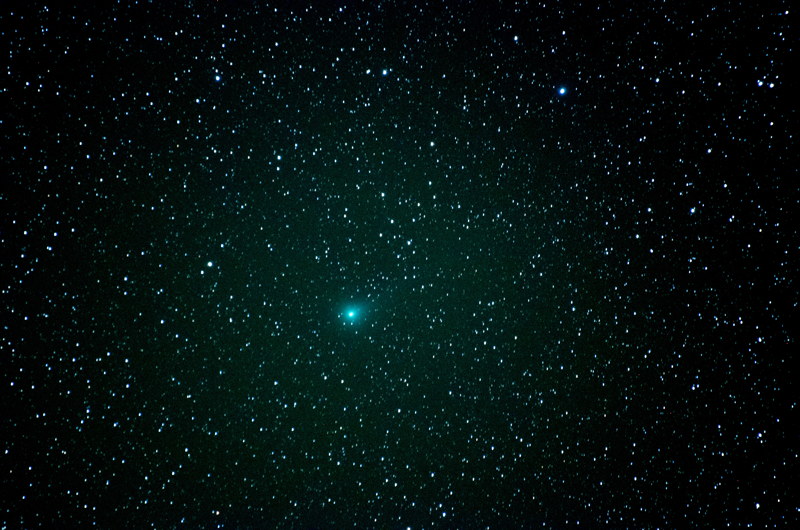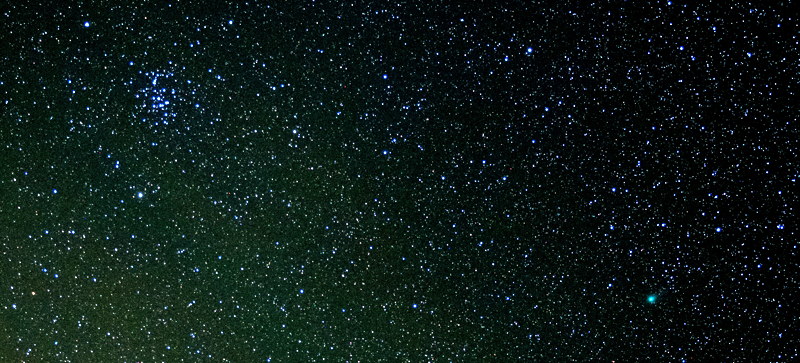
Comet Lovejoy and M44 Beehive Cluster, Comet ISON
Posted: 2 November 2013
Cassiopeia Observatory was opened Friday, 1 November 2013, at 2348 MST, 58°F. The sky was clear and there was no wind. I again opened up later than normal as I would be up late to image comets in the morning sky. At 2356 MST, viewed Jupiter, 83X. Four moons were visible. Then took a quick look at M42 (Great Nebula in Orion), followed by M1 (Crab Nebula). I then began making preparations to image Comet C/2013 R1 (Lovejoy), which was soon to rise over the hill to the east.
Powered on the GC Wi-Fi Adapter and used SkySafari Pro on the iPhone 5s to tell the 8" LX200-ACF to GOTO Comet Lovejoy. At 0013 MST, viewed Comet Lovejoy, 83X, but it was too low for imaging. At 0017 MST, located Comet Lovejoy using 7x50 binoculars as a faint but large fuzzy patch.
Mounted the D7000 DSLR piggyback on the 8" telescope. At 0048 MST, took this guided f/5.6, 5 minute, ISO 6400, 300mm, photo of Comet C/2013 R1 (Lovejoy):

As I was imaging the comet, I noticed that the Beehive Cluster (M44) was nearby. I took this (cropped) guided piggyback photo, f/4.5, 2 minutes, ISO 6400, 70mm, at 0134 MST, showing M44 at the upper left and Comet Lovejoy at the lower right:

I completed piggyback imaging at 0147 MST and set up for prime focus imaging. The D7000 was mounted on the 8" telescope using the off-axis guider. As I was preparing for prime focusing imaging, strong breezes started blowing. (They continued the rest of the session.) After doing a focus test on the star Procyon using the Bahtinov Mask, slewed back to Comet Lovejoy. It was visible in the camera viewfinder. Did some framing test exposures while searching for a guide star. Found a very faint one. Beginning at 0220 MST, I did a guided 2 minute, ISO 6400, exposure at 30 minute intervals. This animated GIF shows the movement of Comet C/2013 R1 (Lovejoy) over a one hour period:

At 0322 MST, the breezes were stronger and with more frequent strong gusts. Slewed the 8" telescope to Comet C/2012 S1 (ISON), which was just rising over the hill to the east. I tried to locate Comet ISON using 7x50 binoculars; no luck. Nor was it visible in the 7x50 finderscope on the telescope. Could not find a suitable guide star either.
At 0400 MST, I began a series of images, unguided, 2 minutes, ISO 6400, one every 30 minutes. At 0430 MST, there were strong wind gusts and I decided to close the dome in between the remaining images. This animated GIF (cropped) shows the movement of Comet C/2012 S1 (ISON) over the 90 minute period, as it rose from very low in the sky:

I ended imaging at 0533 MST, unmounted the camera from the 8" telescope, and viewed Comet ISON, 83X. It was still a very faint object.
The observatory was closed at 0550 MST, 59°F.
Comments are welcome; use the Comments section below, or you can Email Me. Thanks.
Cassiopeia Observatory Home Page